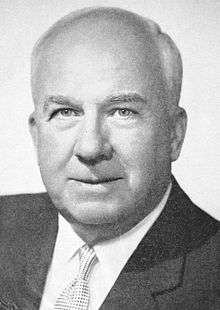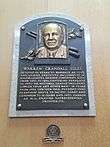Warren Giles
Warren Crandall Giles (May 28, 1896 – February 7, 1979) was an American professional baseball executive. Giles spent 33 years in high-level posts in Major League Baseball as club president and general manager of the Cincinnati Reds (1937–1951) and president of the National League (1951–1969), and was elected to the National Baseball Hall of Fame.
| Warren Giles | |
|---|---|
 Giles in 1962 | |
| Reds GM from 1937–1951, NL president 1951-1969 | |
| Born: May 28, 1896 Tiskilwa, Illinois | |
| Died: February 7, 1979 (aged 82) Cincinnati, Ohio | |
| Member of the National | |
| Induction | 1979 |
| Election Method | Veterans Committee |
Born in Tiskilwa, Illinois,[1] Giles attended Washington & Lee University[2] and served as an infantry officer in France during World War I. Before becoming a full-time baseball executive he worked as a football and basketball official in the Missouri Valley Conference, a major U.S. college sports league.[3]
President/GM of the Cincinnati Reds
Giles was elected president of the Moline, Illinois, Plowboys baseball club in the Class B Three-I League at age 23 in 1919, beginning his 50-year career in baseball.
He then joined the St. Louis Cardinals' organization and rose to prominence as the president and business manager of their top-level farm teams, the Syracuse Stars (1926–27) and Rochester Red Wings (1928–1936) of the International League. As a foreshadowing of his most powerful position in professional baseball, Giles spent part of the 1936 season as president of the International League.
Upon the recommendation of Cardinals' executive Branch Rickey, Powel Crosley Jr., owner of the Cincinnati Reds, appointed Giles as his club's general manager and president on November 1, 1936, succeeding Larry MacPhail.[4] While the 1937 Reds won only 56 games and slid into the basement of the National League, the 1938 edition improved by 26 games to finish in the first division, earning Giles the 1938 Major League Executive of the Year award from The Sporting News. That season, he hired a future Hall of Fame manager, Bill McKechnie, to take charge of the Reds on the field. Then, on June 13, 1938, Giles swung one of the most successful trades in Cincinnati history, when he obtained starting pitcher Bucky Walters from the Philadelphia Phillies for catcher Spud Davis, pitcher Al Hollingsworth and cash.
Walters would help lead the Reds of 1939 and 1940 to back-to-back National League championships. The 1939 Reds, behind Walters' 27 victories and MVP-Award-winning season, captured the NL pennant by 4½ games, but they were swept by the New York Yankees in the World Series. Unfazed, the 1940 Reds won 100 games, with Walters accounting for 22 victories and leading the circuit in earned run average for a second straight season. They repeated as league champions by a 12-length margin, then, behind Walters' two complete game victories, they defeated the Detroit Tigers in a seven-game World Series for the second world title in modern club history.
The Reds boasted .500 or above teams through 1944, but declined beginning in 1945 and during the post-war era finished in the NL's second division and posted losing records for Giles' last seven seasons as the Reds' top executive.[5]
Nevertheless, Giles was a leading candidate to become baseball's third commissioner after Happy Chandler was fired in 1951. He was runner-up in the commissioner balloting to Ford Frick but succeeded Frick as president of the National League on October 8, 1951.[3][6]
National League president
During his 18-year reign as chief executive of the Senior Circuit (including the full seasons of 1952–1969), Giles presided over several historic events.
The NL opened the West Coast and Southeastern United States territories by approving the transfers of the Los Angeles Dodgers and San Francisco Giants in 1958, and the Atlanta Braves in 1966. Giles' first full season, 1952, had been the last in which the eight-team league operated in the same cities as it had since 1900. In March 1953, the Braves pulled up stakes in Boston, where they had played since 1876 as a charter member of the National League, and moved to Milwaukee. That transfer—initially wildly successful, although the Braves would stay in Milwaukee only 13 seasons before settling in Atlanta—was the first in the series of franchise moves that shook Major League Baseball for the next two decades.
In addition, Giles' National League expanded to 12 teams by adding two clubs in both 1962 and 1969. Although "who says you have to have a team in New York?"[3] was Giles' notorious reply when asked if his league would seek to replace the Dodgers and Giants in New York City, the 1962 expansion, which created the Mets, returned the Senior Circuit to the city after a four-year absence. The same expansion brought Major League Baseball to Texas and the Southwest, with the Houston Colt .45s. In 1969, Giles' last year in office, his league expanded into Canada with the Montreal Expos, adopted divisional play, and played the first National League Championship Series, between the Braves and Mets. Between 1952 and 1969, the NL's member clubs, with the exception of the Chicago Cubs, also opened or were planning to open new stadiums.
Giles' presidency also saw the National League widen its advantage over the American League in the signing of African-American and Latin American players, resulting in a three-decade-long domination of the Major League Baseball All-Star Game. In clubhouse meetings before the midsummer classic, Giles famously would exhort the NL's players to uphold their league's honor. During his tenure, the National League won 16 of 22 All-Star games played, with one tie. (Two games were played each year from 1959 to 1962.) The NL also won ten of 18 World Series during Giles' term.
In addition, Giles worked vigorously to keep premier players in his league. After the advent of interleague trading without waivers in November 1959, he lobbied against the trade of National League superstars to the American League to preserve the NL's hegemony. He was successful until his former team, the Reds, traded Frank Robinson to the Baltimore Orioles after the 1965 season. Under Giles, the National League began a 33-year (1956–88) streak during which it dominated the American League in attendance—a remarkable achievement, given that the Junior Circuit had two more member teams than the NL during 13 of those seasons (1961; 1977–88).[7]
During the early weeks of the 1963 season, Giles became a figure of some controversy after he instructed the NL's umpires to strictly enforce the balk rule then in place. In response, the Senior Circuit's arbiters called 74 balks from the opening of the season on April 8 until April 26, when Giles announced a relaxation of the policy.[3][8] Only two balks were called in the American League over the same period.[8]
Giles, then 73, announced his intention to retire after the 1969 season and on December 5, Giants' executive Chub Feeney was elected to succeed him. Under Feeney, league president through 1986, the NL's All-Star Game dominance would continue, with 14 triumphs in 17 games.
Hall of Fame honors

Giles was elected to the Cincinnati Reds Hall of Fame in 1969 and the Baseball Hall of Fame by the Veterans Committee in 1979 shortly after his death in Cincinnati at age 82. Giles is interred in Riverside Cemetery in Moline, Illinois.
The National League Championship Series trophy is named in his honor.[9] Also, Minor League Baseball gives out the Warren Giles Award to outstanding minor league presidents.[10][11][12]
His son, Bill Giles, has also had lengthy baseball career. After serving as an executive with the Reds, Houston Colt .45s/Astros and Phillies, he became a part-owner of the Phillies in 1981, and served as their club president until 1997 before becoming board chairman and then chairman emeritus. Following in his father's footsteps, Bill Giles is also honorary president of the National League.
References
- "Giles, Warren/ Baseball Hall of Fame". National Baseball Hall of Fame and Museum. Retrieved 8 May 2013.
- Sportsecyclopedia.com
- Sports Illustrated, June 10, 1963
- Armour, Mark, Warren Giles. SABR Biography Project
- Retrosheet
- United Press International, February 8, 1979
- Studenmund, Dave; Tamer, Greg (2004). The Hardball Times 2004 Baseball Annual. The Hardball Times.
- United Press International, 1963-04-26
- Jensen, Mike (October 16, 2008). "'Fantastic feeling' for Bill Giles". Philadelphia Inquirer. Retrieved 2009-08-17.
- "History: MiLB Major Award Winners". Minor League Baseball. Retrieved 2011-10-15.
- Avallone, Michael (November 19, 2007). "Minor League Baseball announces top honorees: Annual awards salute outstanding organizations and executives". MLB.com. Minor League Baseball. Retrieved 2011-10-06.
[Presented] annually to a league president for exceptional service.
- Czerwinski, Kevin T. (December 14, 2006). "McEacharn claims 2006 Warren Giles Award". MinorLeagueBaseball.com. Retrieved 2011-10-06.
External links
- Warren Giles at the Baseball Hall of Fame
- Baseball Library.com – biography and career highlights
| Preceded by Charles Knapp |
International League President 1936 |
Succeeded by Frank Shaughnessy |
| Preceded by Larry MacPhail |
Cincinnati Reds General Manager 1937–1951 |
Succeeded by Gabe Paul |